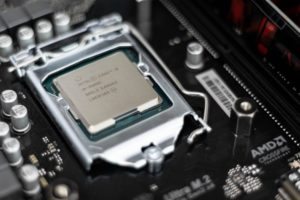On your marks, get set, go! There was no Olympics this year. No Usain Bolt. But there’s another race going on, and the competitors are gunning for gold. Over the last few decades, tech companies have raced to create the world’s fastest processor. But who will be the champion? And who will fall at the final hurdle?
The main competitors:
- Intel
- AMD
The last-minute addition:
- Apple
But before we crown the winner, we need to go back to the starting line.
Intel: The Favorite to Win the Race
Intel created the first commercial microprocessor (the 4004) back in ’71 and introduced an 8-bit microprocessor (the 8008) a year later [1]. By the mid-’70s, most printers, cash registers, and terminals used Intel microprocessors like the 8080, which became the blueprint for subsequent designs. The company has pretty much dominated the CPU market ever since.

Intel had little competition in the ’70s. Panafacom — a company formed by Fujitsu, Panasonic, and Fuji Electric — introduced a commercial 16-bit microprocessor called the MN1610 in ’75 [2]. But there was little else that broke into the mainstream.
Intel continued its reign into the ’80s and ’90s. Sure, other companies joined the CPU race — Motorola in ’85 with the 32-bit 68020+68851; ARM in ’85; and Hitachi in ’92 — but Intel became synonymous with processors. It introduced the 80286 in ’82; the 32-bit 80386 in ’85; and the original Pentium microprocessor in ’93. (This was the first processor with the now-famous x86 “superscalar” micro-architecture.)
Intel had few competitors. But this was about to change.
AMD(American Micro Devices) Joins the CPU Race
AMD introduced x86-64 extension to the popular x86 micro-architecture in 2000. Just a year later, AMD released the Athlon (with 1 GHz!) Two years after this, AMD introduced the Athlon 64 — the world’s first 64-bit consumer CPU [3].
AMD was coming for Intel’s throne. AMD technologies proved popular and established the company as a genuine rival to Intel, which hit back with the Pentium 4, one of its most iconic models.
Intel released subsequent models under the Pentium brand name — the Pentium M in 2000 and the Pentium D in 2006 — then vPro in 2007 and the Core i-Series and Atom in 2008. The company moved to the new Platform Controller Hub (PCH) design in 2010, eliminating its famous Northbridge chip.

Intel vs. AMD
Over the last decade, Intel and AMD have raced neck and neck. The biggest developments? Intel released its Core i3, i5, and i7 processors in 2010, while AMD released the first 8-core CPU for desktops and Ryzen processors based on Zen architecture in 2011 and 2017, respectively.
For the last 10 years or so, Intel chips tend to rank better when it comes to performance per core [4], but AMD offers more “cores” for money and advanced onboard graphics. Value-for-money is around the same. We think both companies make great laptop processors. However, AMD scores better on desktop CPUs. Our honest opinion: Intel’s products have lost their edge over the last few years, while AMD continues to innovate.
Could Apple Win the CPU Race?
Earlier this year, Apple shocked the tech sector by entering the CPU race [5]. It will create its own processors for MacBooks (based on ARM architecture). Welcome to Apple Silicon. Of course, Apple has used Intel products for years, so this development came as a shock to many of us in the industry.
We welcome this news. Apple has created strong CPUs for iPhones and iPads for a while now, and market diversity is always good.
The Winner
Intel has long been the CPU market leader, but things are changing. AMD continues to create strong products, and Apple has joined the race. But which product should you choose? It depends on various factors like device (desktop or laptop?), function (gaming or business?), and price.
There’s a lot of choices out there nowadays and, as Apple proves, there’s much more to CPUs than just Intel!
Sources:
[1] http://www.vintagecalculators.com/html/busicom_141-pf_and_intel_4004.html
[2] http://www.cpu-museum.com/161x_e.htm
[3] http://www.cpu-world.com/CPUs/K8/TYPE-Athlon%2064.html
[4] https://www.digitaltrends.com/computing/amd-vs-intel/#:~:text=Overall%2C%20both%20companies%20produce%20processors,price%20and%20better%20onboard%20graphics.
[5] https://www.trustedreviews.com/news/four-reasons-why-apple-is-right-to-snub-intel-and-amd-4038431




